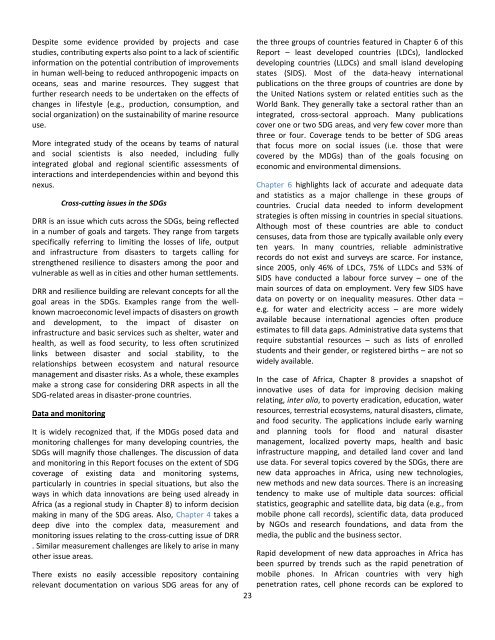1HlG51J
1HlG51J
1HlG51J
Create successful ePaper yourself
Turn your PDF publications into a flip-book with our unique Google optimized e-Paper software.
Despite some evidence provided by projects and casestudies, contributing experts also point to a lack of scientificinformation on the potential contribution of improvementsin human well-being to reduced anthropogenic impacts onoceans, seas and marine resources. They suggest thatfurther research needs to be undertaken on the effects ofchanges in lifestyle (e.g., production, consumption, andsocial organization) on the sustainability of marine resourceuse.More integrated study of the oceans by teams of naturaland social scientists is also needed, including fullyintegrated global and regional scientific assessments ofinteractions and interdependencies within and beyond thisnexus.Cross-cutting issues in the SDGsDRR is an issue which cuts across the SDGs, being reflectedin a number of goals and targets. They range from targetsspecifically referring to limiting the losses of life, outputand infrastructure from disasters to targets calling forstrengthened resilience to disasters among the poor andvulnerable as well as in cities and other human settlements.DRR and resilience building are relevant concepts for all thegoal areas in the SDGs. Examples range from the wellknownmacroeconomic level impacts of disasters on growthand development, to the impact of disaster oninfrastructure and basic services such as shelter, water andhealth, as well as food security, to less often scrutinizedlinks between disaster and social stability, to therelationships between ecosystem and natural resourcemanagement and disaster risks. As a whole, these examplesmake a strong case for considering DRR aspects in all theSDG-related areas in disaster-prone countries.Data and monitoringIt is widely recognized that, if the MDGs posed data andmonitoring challenges for many developing countries, theSDGs will magnify those challenges. The discussion of dataand monitoring in this Report focuses on the extent of SDGcoverage of existing data and monitoring systems,particularly in countries in special situations, but also theways in which data innovations are being used already inAfrica (as a regional study in Chapter 8) to inform decisionmaking in many of the SDG areas. Also, Chapter 4 takes adeep dive into the complex data, measurement andmonitoring issues relating to the cross-cutting issue of DRR. Similar measurement challenges are likely to arise in manyother issue areas.There exists no easily accessible repository containingrelevant documentation on various SDG areas for any of23the three groups of countries featured in Chapter 6 of thisReport – least developed countries (LDCs), landlockeddeveloping countries (LLDCs) and small island developingstates (SIDS). Most of the data-heavy internationalpublications on the three groups of countries are done bythe United Nations system or related entities such as theWorld Bank. They generally take a sectoral rather than anintegrated, cross-sectoral approach. Many publicationscover one or two SDG areas, and very few cover more thanthree or four. Coverage tends to be better of SDG areasthat focus more on social issues (i.e. those that werecovered by the MDGs) than of the goals focusing oneconomic and environmental dimensions.Chapter 6 highlights lack of accurate and adequate dataand statistics as a major challenge in these groups ofcountries. Crucial data needed to inform developmentstrategies is often missing in countries in special situations.Although most of these countries are able to conductcensuses, data from those are typically available only everyten years. In many countries, reliable administrativerecords do not exist and surveys are scarce. For instance,since 2005, only 46% of LDCs, 75% of LLDCs and 53% ofSIDS have conducted a labour force survey – one of themain sources of data on employment. Very few SIDS havedata on poverty or on inequality measures. Other data –e.g. for water and electricity access – are more widelyavailable because international agencies often produceestimates to fill data gaps. Administrative data systems thatrequire substantial resources – such as lists of enrolledstudents and their gender, or registered births – are not sowidely available.In the case of Africa, Chapter 8 provides a snapshot ofinnovative uses of data for improving decision makingrelating, inter alia, to poverty eradication, education, waterresources, terrestrial ecosystems, natural disasters, climate,and food security. The applications include early warningand planning tools for flood and natural disastermanagement, localized poverty maps, health and basicinfrastructure mapping, and detailed land cover and landuse data. For several topics covered by the SDGs, there arenew data approaches in Africa, using new technologies,new methods and new data sources. There is an increasingtendency to make use of multiple data sources: officialstatistics, geographic and satellite data, big data (e.g., frommobile phone call records), scientific data, data producedby NGOs and research foundations, and data from themedia, the public and the business sector.Rapid development of new data approaches in Africa hasbeen spurred by trends such as the rapid penetration ofmobile phones. In African countries with very highpenetration rates, cell phone records can be explored to




